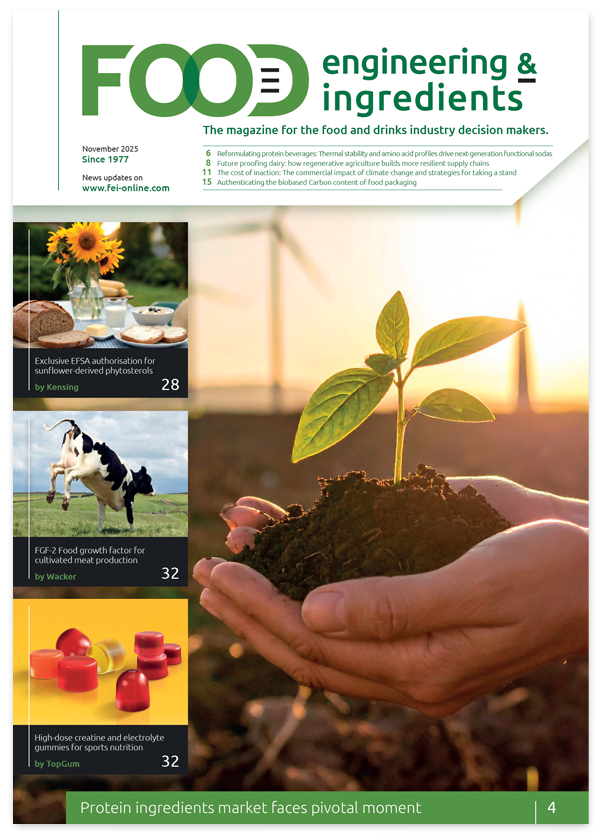Protein ingredients market faces pivotal moment
Trade tariffs, shifting consumer preferences, and emerging technologies are converging to reshape the protein ingredients sector, with traditional dairy proteins maintaining dominance whilst plant-based alternatives struggle to gain a foothold in premium categories. Graham C. Robinson, CEO of Giract, explores this dynamic market.
The protein ingredients market is at a potential pivot point. A combination of supply side and demand side factors are coalescing to make the market harder than ever to predict.
Trade tariffs have occupied the news for much of 2025, with analysts speculating on the impacts for the ingredients markets. Frankly, the degree of uncertainty in the markets is so high that it is difficult for companies to strategize meaningfully, and most have decided to continue with business as usual and make course-corrections as and when required.
Plant-based proteins may stand to be particularly impacted. One of the key features of the plant protein ingredients market is that China is a significant processor and supplier of pea protein, which has seen rapid market expansions in recent years. The current high tariff rate on Chinese products exported to the USA means that Chinese pea protein is no longer price competitive in North America; however, it will still take time to establish how restructured trade flows will impact other pea protein markets.
Milk and dairy commodity prices have been falling over recent months, resulting in more competitive pricing for many dairy ingredients. However, demand for milk proteins and whey proteins has remained strong; buoying the market for these ingredients. This has added pressure on plant-based proteins, which have long since struggled to expand market foothold in functional nutrition categories; the high-value categories in which dairy proteins hold so much sway.
Consumer trends reshape protein demand
On the consumer side, we have witnessed slowing growth of plant-based meat analogs, and an attempt by plant-based protein suppliers to pivot to dairy alternatives. The projected volume demand growth for protein ingredients in dairy alternatives (5.6% CAGR 2024-2029) now exceeds that for meat analogs (5.2% CAGR 2024-2029) explains, Mathivanan Govindhan, Head of Research at Giract (Source: Giract, Global Protein Ingredients 2024-2029).
This is not without its challenges, as plant-based dairy alternatives provide technical hurdles to product formulation. Unlike plant-based meat analogs, which are dark coloured and powerfully flavoured (typically, strong savoury base notes provided by yeast extracts or HVP, for instance); dairy alternatives tend to be lightly coloured and lightly flavoured. This poses a challenge to some plant-based protein sources, which carry off-colours and off-flavours, and are difficult to mask in the dairy alternative matrix.
The hybrid meat (products containing approximately equal proportions of meat and plant-based protein) category is threatening a rebirth. However, this category is unlikely to
provide a major supply channel to plant-based protein suppliers, as it did not gain a substantial foothold in the market following the excitement around this category three to four years ago; and it’s not clear that things will be different this time.
Precision fermentation poised to disrupt market
The precision fermentation sector stands poised to pile more pressure on the plant-based proteins market, as companies such as Perfect Day, ImaginDairy, and Remilk launch precision fermented proteins identical to their whey and dairy counterparts; and DairyX launched a yeast-derived casein for the production of cow-free cheese. However, legislative hurdles remain, particularly for Europe, which imposes strict novel food status for new ingredients, and the question of consumer acceptance of such precision fermented proteins is still to be addressed.
The humanisation of the pet food category provides one of the strongest drivers for plant-based protein ingredient demand, as pet owners are increasingly prepared to pay premiums for products for their pets that align with their own clean-label driven diets. Govindhan explains that the pet food category is set to add an additional 40kt of protein ingredient demand to 2029 (2.2% CAGR) on top of what is already a substantial market size (Source: Giract, Global Protein Ingredients 2024-2029).
Mathivanan Govindhan, Head of Research at Giract
GLP-1 drugs create new market opportunities
One of the biggest trends to hit the food and beverage industry, however, is GLP-1. J.P. Morgan Research estimates that the GLP-1 market will exceed US$100 billion by 2030. We have already seen numerous brands positioning their products for GLP-1 complementation. In January 2025, Conagra Brands launched its On Track badge, a front-of-pack label indicating products that are high in protein, fibre, and nutritional density. Herbalife launched a range of GLP-1 Nutrition Companion products for users of GLP-1 receptor agonist drugs. As more and more consumers also become users of these drugs it is likely that GLP-1 companion labelling will become recognised as a barometer for holistic wellness and may even become the de facto standard for clean-labelling. This situation is similar to how the organic label is viewed in many European countries.
Animal feed remains largest volume driver
One of the most over-looked application sectors for protein ingredients is animal and aquaculture feed. It is not a glamorous category and does not occupy the news in the same way that meat analogs or dairy alternatives do, but in terms of volume – and more importantly, volume growth – it is one of the key driving forces of the protein ingredients market. From reading the ingredients industry news, it is tempting to think that dairy alternatives and functional nutrition are driving demand for protein ingredients. While protein demand in these categories is growing rapidly (5.6% and 6.4% CAGR% 2024-2029, respectively. Source: Giract, Global Protein Ingredients 2024-2029) this growth is from a small base; consequently, these rapid growth rates do not translate into large additional protein demand. Conversely, the animal and aquaculture feed sector is growing much more slowly (1.7% CAGR% 2024-2029; Source: Giract, Global Protein Ingredients 2024-2029). However, due to the sheer size of the sector this translates into approximately 140kt additional protein demand globally by 2029 (Source: Giract, Global Protein Ingredients 2024-2029). This dwarfs the additional protein volume demand for much trendier food and beverage categories.
It is also tempting to think that the animal and aquaculture feed sector is simply a sink market for commodity ingredients. However, this is incorrect. While a lot of protein is delivered through low-cost agri-processing co-products, such as soybean meal, higher value protein ingredients, such as protein isolates and hydrolysates are added to speciality animal feed products, such as calf milk replacers (CMR) and piglet milk replacers (PMR). These products are designed to facilitate rapid weight gain by juvenile animals, and protein isolates and hydrolysates provide a valuable source of soluble, bioavailable protein. These proteins occupy an important niche between the commodities, such as soybean meal, and very high-value nutrients, such as lysine, and other purified amino acids.
Another common misconception with the animal and aquaculture feed sector is that its product category – meat and fish – is a dying market, whose glory days are behind it. Again, this is untrue. While some countries are seeing a decline in meat consumption (typical examples being Germany, France, and the UK) this is a Western-centric trend; global meat consumption is increasing. As meat consumption is linked to GDP, as per capita GDP increases across the developing world, so too does meat consumption – and therefore, demand for animal and aquaculture feed. Projections by international institutions, such as the OECD and the World Bank indicate that this pattern is not set to change anytime soon. A multitude of factors are combining to provide the requisite ingredients for a pivotal change in the protein ingredients market, and market-watchers will certainly be busy in the coming months and years.
About the author
Graham Robinson is CEO of Giract and a Cambridge-trained biochemist with broad expertise in food ingredients and over a decade of research experience in metabolism and vitamin biosynthesis.




